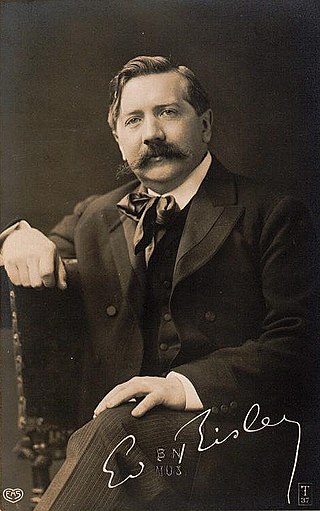Related Research Articles

Tristan und Isolde, WWV 90, is an opera in three acts by Richard Wagner to a German libretto by the composer, based largely on the 12th-century romance Tristan and Iseult by Gottfried von Strassburg. It was composed between 1857 and 1859 and premiered at the Königliches Hoftheater und Nationaltheater in Munich on 10 June 1865 with Hans von Bülow conducting. Wagner referred to the work not as an opera, but called it "eine Handlung".
This article is about music-related events in 1865.

Alexis-Emmanuel Chabrier was a French Romantic composer and pianist. His bourgeois family did not approve of a musical career for him, and he studied law in Paris and then worked as a civil servant until the age of thirty-nine while immersing himself in the modernist artistic life of the French capital and composing in his spare time. From 1880 until his final illness he was a full-time composer.

Felix Josef von Mottl was an Austrian conductor and composer. He was regarded as one of the most brilliant conductors of his day. He composed three operas, of which Agnes Bernauer was the most successful, as well as a string quartet and numerous songs and other music. His orchestration of Richard Wagner's "Wesendonck Lieder" is still the most commonly performed version. He was also a teacher, and his pupils included Ernest van Dyck and Wilhelm Petersen.

Le roi malgré lui is an opéra-comique in three acts by Emmanuel Chabrier of 1887 with an original libretto by Emile de Najac and Paul Burani. The opera is revived occasionally, but has not yet found a place in repertory.

Ernest Van Dyck was a Belgian dramatic tenor who was closely identified with the Wagnerian repertoire.

Briséïs or Les amants de Corinthe is an operatic drame lyrique by Emmanuel Chabrier with libretto by Catulle Mendès and Ephraïm Mikaël after Goethe's Die Braut von Korinth.

Fisch-Ton-Kan is an opéra bouffe in one act by Emmanuel Chabrier of which only some numbers survive. The French libretto was by Paul Verlaine, and probably Lucien Viotti, after the 'parade chinoise' Fich-Tong-Khan ou L'orphelin de le Tartarie of 1835 by Thomas Sauvage (1794-1877) and Gabriel de Lurieu (1792-1869).

"Bourrée fantasque" is a piece of music for solo piano by Emmanuel Chabrier (1841–1894), being one of his last major completed works.
España, rhapsody for orchestra is the most famous orchestral composition by French composer Emmanuel Chabrier (1841–1894). Written in 1883 after a trip to Spain, it was dedicated to the conductor Charles Lamoureux, who conducted the first public performance on 4 November 1883, at the Théâtre du Château d’Eau for the Société des Nouveaux Concerts in Paris.

Joseph-Édouard Risler was a French pianist.
Pièces pittoresques are a set of ten pieces for piano by Emmanuel Chabrier. Four of the set were later orchestrated by the composer to make his Suite pastorale.
The Trois valses romantiques are a set of three pieces for two pianos by Emmanuel Chabrier.

Joyeuse marche is a popular orchestra piece by the French composer Emmanuel Chabrier. It is the second half of a pair of orchestral pieces first performed on 4 November 1888 in Angers, conducted by the composer. The Joyeuse marche is dedicated to Vincent d'Indy.

Vaucochard et fils Ier is an unfinished opérette by Emmanuel Chabrier of which only some numbers survive. The French libretto was by Paul Verlaine.
Roger Delage was a French musicologist and conductor. He was the leading authority on the life and works of the composer Emmanuel Chabrier, and as a conductor was known for reviving the music of early French composers such as Guillaume de Machaut.

The French composer Emmanuel Chabrier (1841–1894) wrote music in many genres, including opera and operetta, piano, orchestral music, and songs with piano accompaniment. The songs cover most of his creative years, from the early 1860s to 1890, when the illness which would kill him prevented much composition. He came late to music as a profession, but – although being an exceptional pianist – he had no trappings of a formal training: no conservatoire studies, no Prix de Rome, "none of the conventional badges of French academic musicians, by whom he was regarded as an amateur".

Tristan and Isolde is the title of two oil paintings by the Spanish artist Rogelio de Egusquiza. Both works are based on the opera Tristan und Isolde by the German composer Richard Wagner, whom Egusquiza idolised. The first painting, subtitled Death and also known as La mort d'Isolde, was completed in 1910 and depicts Isolde's "Liebestod", as she collapses in death upon the lifeless body of Tristan. The second painting, subtitled Life, was completed two years later and depicts the lovers embracing in the night, a scene from the second act of Wagner's opera.
References
- 1 2 3 4 Delage R. Emmanuel Chabrier. Fayard, Paris, 1999.
- ↑ Myers R. Emmanuel Chabrier and his circle. J M Dent and Sons, London, 1973.
- ↑ Poulenc F. Emmanuel Chabrier. La Palatine, Geneva & Paris, 1961.
- ↑ Howat R. The Art of French Piano Music. Yale University Press, 2009.
- ↑ ‘Quadrille’ in the Grove Dictionary of Music.